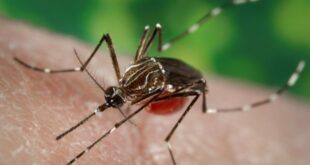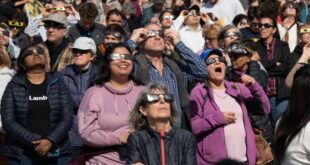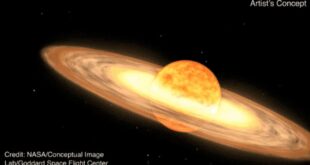Preserved animals provide rare direct glimpse into ancient interactions.

A badger-like mammal died while chomping into the ribs of a hapless horned plant-eating dinosaur struggling to escape more than 100 million years ago. The pair were perfectly preserved, still locked in combat, in “China’s dinosaur Pompeii,” researchers report.
Dating to the Cretaceous Period, the dramatic fossil unearthed in northeastern China shows the four-legged mammal Repenomamus robustus — the size of a domestic cat — ferociously entangled with the beaked two-legged dinosaur Psittacosaurus lujiatunensis, as big as a medium-sized dog.
Scientists suspect they were suddenly engulfed in a volcanic mudflow and buried alive during mortal combat.
“Dinosaurs nearly always outsized their mammal contemporaries, so traditional belief has been that their interactions were unilateral — the bigger dinosaurs always ate the smaller mammals,” said paleobiologist Jordan Mallon of the Canadian Museum of Nature in Ottawa, who helped lead the study published in the journal Scientific Reports.
“Here, we have good evidence for a smaller mammal preying on a larger dinosaur, which is not something we would have guessed without this fossil,” Mallon said.

A complex food web
Most mammals during the Mesozoic Era, the age of dinosaurs, were shrew-sized bit players in the larger theatre of life, doing well to avoid becoming someone else’s lunch. Repenomamus shows that at least some mammals gave as good as they got.
“I think what’s key here is that Mesozoic food webs were more complex than we had imagined,” Mallon said.
The area in Liaoning Province where the virtually complete fossil was found is called the “Chinese Pompeii,” owing to various fossils of animals buried in volcanic eruptions.

Examining the fossil was like a crime scene analysis. Repenomamus is perched atop the prone Psittacosaurus, gripping the jaw and hind leg while biting into the ribcage. Repenomamus measures 47 centimetres (18 inches) long. Psittacosaurus is 120 centimetres (four feet) long. Both are thought to be not quite full adults.
“There have been specimens of carnivorous dinosaurs preying on plant-eating dinosaurs before, but there has never been an example of a mammal preying on a dinosaur,” said Canadian Museum of Nature paleontologist and study co-author Xiao-Chun Wu.
Preserved in battle
It is rare to find fossils showing animals interacting. Another fossil found in the 1970s in Mongolia shows two dinosaurs — predator Velociraptor and plant-eater Protoceratops — fighting about 80 million years ago before being buried alive, perhaps in a collapsing sand dune.
The researchers discounted the idea that the Repenomamus and Psittacosaurus fossil showed a mammal merely scavenging a carcass.

“For one, the mammal is on top of the dinosaur as though it was trying to subdue it, which the scavenging hypothesis doesn’t account for,” Mallon said.
“Second, there are no bite marks on the bones of the dinosaur, which we would expect if it had been sitting out for long, exposed to scavengers. Lastly, the hind foot of the mammal is trapped by the folded hind leg of the dinosaur, which is unlikely to have happened if the dinosaur had already been dead when the mammal came across it,” he said.
While Psittacosaurus was an early relative of the horned dinosaur lineage, it lacked facial horns and a head crest. It possessed a parrot-like beak to crop plant material.
Repenomamus, one of the dinosaur age’s largest mammals, had short and sprawling limbs, a long tail, a sinuous body, a robust skull and shearing teeth. Mallon compared its appearance to the living Chinese ferret-badger.
There was previous evidence of the dino-eating habits of Repenomamus. One Repenomamus fossil from the same area had baby Psittacosaurus bones in its stomach.
“What’s unique about our fossil is the fact that it demonstrates that Repenomamus was capable of tackling larger dinosaur prey,” Mallon said.
*****
Credit belongs to : www.cbc.ca
 Atin Ito First Filipino Community Newspaper in Ontario
Atin Ito First Filipino Community Newspaper in Ontario






